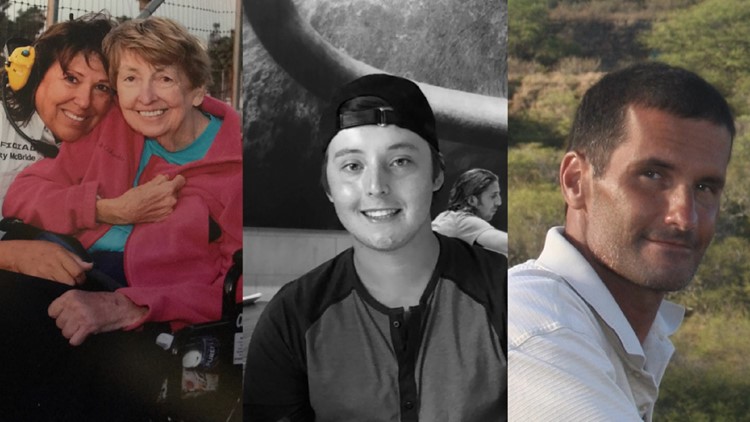SAN DIEGO COUNTY, Calif. — You may have seen that we published a big investigation this week called UNCOUNTED.
The project took more than two months to produce. We spoke with the loved ones of those who died during the pandemic, analyzed four years of mortality data and consulted with several epidemiologists to try to capture the full scope of the loss caused by this year’s COVID-19 pandemic.
Here are the top five takeaways.
1. Roughly 1,000 more San Diego County residents died from March through August than in a normal year – well above the official COVID-19 death tally.
The first six months of the pandemic were far deadlier than normal for county residents.
About 1,181 more residents died than we would expect based on the past three years of mortality data, our analysis found. These are called excess deaths.
The number of deaths we found is 66% higher than the county’s official pandemic death count, which only includes people with positive COVID-19 tests.
But our analysis includes all sorts of people who died during the pandemic, including those who contracted COVID-19 but were never tested, and people who died from the pandemic “indirectly,” like from the stress of losing a job or not being able to get medication because the store is closed.
The classic example of an indirect death is someone with heart attack symptoms who is too scared to go to the hospital because they think they’ll contract the coronavirus, and then they later die at home from a heart attack that could have been easily treated by a doctor.
Dr. Matthew Wynia, the director of a bioethics program at the University of Colorado, said the official count kept by the public health office is important, but it “leads us to underestimate the total impact of certain types of disasters.”
2. The uncounted deaths we uncovered are concentrated in minority communities.
Our data shows the pandemic is hitting communities of color even harder than what’s been previously reported in San Diego County.
There are more than twice as many Asian and Black residents in our data than in the county’s, which only includes people with positive COVID-19 tests, and there are about 55% more Hispanic residents.
That means county officials have failed to acknowledge hundreds of Black, Asian and Hispanic residents who died because of the pandemic — and who have left behind grieving families and friends.
According to national research, those who die during the pandemic leave behind an average nine grieving loved ones who are more likely to develop chronic mental illnesses or substance abuse disorders if they don’t receive proper support.
“Honestly, it’s not surprising,” Nancy Maldonado told us. She’s the CEO of the Chicano Federation, a nonprofit that advocates for Latino communities in the region.
“This isn’t the equalizer,” she added. “This isn’t happening the same to everybody. We’re not all in this together.”
3. Deaths at home continue to climb while hospital deaths are mostly flat.
While you might expect that pandemic victims spend their final days of life in the hospital, most of them are actually dying at home.
Deaths at home have continued to climb in San Diego County since the pandemic began, while hospital deaths have stayed mostly steady compared to previous years.
Experts pointed to a few reasons for this. For one, a coronavirus infection can become serious very quickly, so you might not make it to a hospital before you die.
Another explanation is that people who don’t have the virus are too scared to go to the hospital, thinking they might contract COVID-19 from healthcare workers or other patients, and end up dying at home.
Deaths at home present a big conundrum for researchers trying to figure out exactly how many people died directly from COVID-19 infections. When someone dies suddenly at their house, there’s a good chance they were never tested for the virus, so the cause of death can be harder to determine.
4. The Medical Examiner’s Office is testing bodies for COVID-19.
The county Medical Examiner’s Office can test bodies for the virus, and if they find a positive result, include that information on the person’s death certificate. This is one way someone can end up in the county’s official COVID-19 death toll.
Mark Hayward, an epidemiologist at the University of Texas Austin, reviewed the county’s testing protocols and told us the Medical Examiner’s Office appeared to be doing a thorough job, especially compared to smaller, rural counties around the U.S.
The office tested at least 72 people who died at home from March through August, and four of them came back positive. That’s 12% of all home deaths reviewed by the office during that time.
But most people don’t end up at the county morgue when they die, meaning they likely won’t be tested for the virus posthumously. And if they were never tested before they died, the causes of their deaths could remain a mystery.
5. The county pushed back on our reporting, but we published our project anyway.
A spokesperson for the county’s health agency, Sarah Sweeney, told us our analysis was “premature” and shouldn’t be conducted until after the pandemic is over, if at all.
Another staff member from the agency also raised concerns and said the analysis should be used after floods or wildfires rather than during pandemics. (Read this story if you want the full breakdown of what they told us and our response.)
We haven’t found any experts who agree. In fact, eight epidemiologists and mortality researchers we spoke with disagreed with the county’s statements.
“There’s no intellectual basis for them saying what they said,” said David Leon, an epidemiologist at the London School of Hygiene & Tropical Medicine, who published a paper on excess deaths during the COVID-19 pandemic.
Leon said he’s never heard an epidemiologist express these concerns and told us that these estimates allow governments to make better public policy decisions.
“It’s a sensible thing to do,” Leon said.
inewsource is a nonprofit, independently funded newsroom that produces impactful investigative and accountability journalism in San Diego County. Learn more at inewsource.org.



